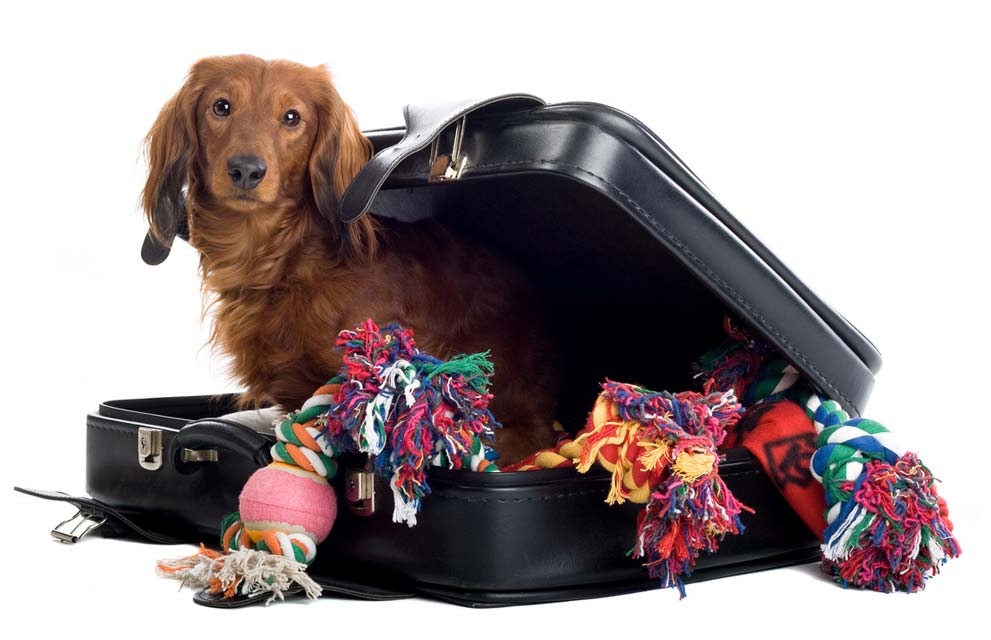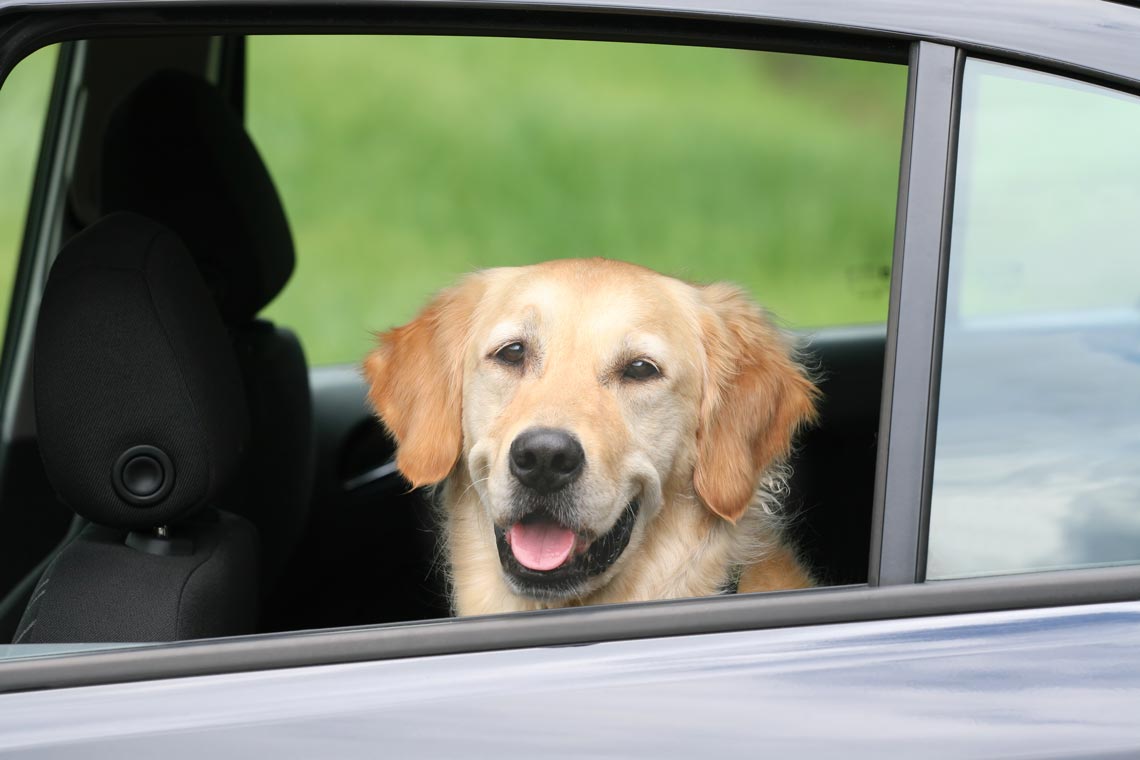Traveling With Your Dog

If you're like most dog-lovers, the first thing you think of when planning a trip or vacation is "what about my dog?" Bringing your dog along can be lots of fun. But poor planning could leave both of you homesick in a hurry. Read on to learn some basic rules of the road.
Dogs on the Go
If you've decided to take your dog along on a trip with you, start by making sure your best friend has proper identification in case he should stray or get lost. This means either a good collar with the appropriate license and ID tags, a microchip, or both. Bring along a current photo of your dog in case you need to create a lost poster. It never hurts to bone up on basic obedience and leash manners before you leave, both for your dog's safety and to save your sanity.
Your next step should be to schedule a visit to the veterinarian. This will ensure that your dog is in good enough health to travel and is current on all necessary vaccinations. Be sure to stock up on heartworm preventative, flea and tick control, and any other prescriptions your pet needs while you're away. This is a good time to get an up-to-date copy of your dog's health records to take along on your trip. These will be required should your pet become ill and have to visit a veterinarian while away from home. Health records are also mandatory should you find that you must board your pet for some unexpected reason during your travels.
Next, it's time to decide how you and your dog are going to get to your destination.
Traveling with Your Dog by Air
Air travel has become more complex and stressful over the past decade and not just for humans. Plan well ahead and be prepared to do a good deal of research and comparison shopping before you book the flight. Rules, restrictions, and fees can vary dramatically depending on the air carrier, your destination, and the time of year.
There are two basic options for the canine passenger: cabin or cargo. Small dogs weighing fifteen pounds or less can usually ride in the cabin. However, the carrier, with your dog inside, must fit under the seat in front of you, and he must stay inside for the duration of the trip. Onboard spots for pets are subject to limited availability, so you'll want to confirm that there's room for your dog on the flight before you commit.
Dogs that fail to meet the weight requirement must be checked along with baggage into the pressurized cargo hold. Restrictions apply here too, and many airlines will not accept dogs whose combined weight with the carrier or crate exceeds 100 pounds. Some airlines do not allow pets in cargo at all.
Here are some questions to consider before you book the flight:
- At what time of year are you traveling? Federal, state, and airline-based regulations prohibit canine travel through areas where extreme temperatures may occur. Animals are prohibited from traveling in cargo if weather conditions on the ground are either too cold (45˚ F or below) or too hot (typically around 85˚F or above) at any stop along the way. Direct, nonstop flights are always advisable when traveling with your dog in order to avoid exposure to extreme heat or cold during layovers.
- What documentation is required? Most airlines require a valid health certificate from your veterinarian. Domestic travel is usually fairly simple. However, some states do have special vaccination requirements, so it's a good idea to check with the State Veterinarian at your destination. The rules for international travel are more complex. At minimum, a USDA health certificate is required. This goes along with whatever documentation, permit, or notarization is required by the country to which you're traveling. For a comprehensive and up-to-date summary of rules and regulations for international travel, visit the USDA Animal and Plant Health Inspection Service (APHIS) website. The importation process can take upwards of six months for heavily-restricted destinations, such as the United Kingdom, Hawaii, Australia, and New Zealand, so it's essential to plan well ahead.
- Is your dog at risk for any health complications? Dogs with frail health or with respiratory or heart conditions may not handle stress well. Restrictions often apply for short-nosed breeds such as pugs, bulldogs, shih-tzus, Lhasa apsos, and Boston terriers. These short-nosed breeds are very sensitive to poor air quality and overheating.
- Is your dog's carrier or crate suitable? Federal guidelines dictate the size, strength, ventilation, labeling, and sanitary provisions for pet carriers and kennels traveling in airline cargo holds. Steer clear of cheap carriers that could open or break in transit. Soft-sided carriers are a nice option for pets that will travel in the cabin with you, as long as they are secure. It's best to check with the individual airline for specific requirements.
- Is your dog's temperament suitable for air travel? Dogs with separation anxiety, aggression issues, those who bark incessantly or who just don't tolerate being caged or crated are not the best candidates for the friendly skies. Dogs traveling in the cabin must be able to endure being taken in and out of the carrier for inspection when going through security. A strong leash and harness are essential to making sure a startled pet can't bolt and become lost.

Traveling with Your Dog by Car
Let's face it: going by car can be a lot less stressful and a good deal cheaper than flying for all concerned. Most dogs are used to traveling in cars and may even associate it with fun experiences, like trips to the park. To ensure your dog's safety while riding, consider purchasing an appropriately-sized doggie seatbelt or restraint harness. For everyone's safety, dogs should be confined in the back seat or rear compartment of the vehicle. This reduces the risk that your dog will distract you while you are driving, or worse, be injured if the vehicle stops short or is involved in an accident.
When you and your dog head out on the highway, plan to make regular stops. Take a break at least once every three hours so your dog can relieve himself, stretch his legs, and get a drink of water. Keep meals and snacks small while en route to prevent motion sickness. Always keep your pet on a leash in unfamiliar surroundings. Never leave your dog alone in the car, even in the shade, even for a short time. Unattended cars can dangerously overheat surprisingly quickly.
Don't forget to pack the necessities (see box), including your dog's own food, treats, and possibly water from home as a safeguard against tummy troubles. If you'll be on the road for a while, check out Dogfriendly.com for restaurants, activities, and lodging that allow dogs.
If it's a big move you're making, consider leaving it to the professionals, such as PetMovers.com.
Since emergencies can happen, even away from home, don't forget to take a dog first aid kit such as this one.
Travel Checklist for the Well-Prepared Dog
Snacks
Food
Bottled water and a canteen
Outerwear, if needed
There's No Place like Home
If a "stay-cation" is more up your dog's alley, there are three main options: boarding, in-home care, or entrusting your dog to family and friends. Your veterinarian knows your dog's health and temperament and may be able to assist you with recommendations. Following are some online resources for finding suitable professional care for your canine while you're away:
National Association of Professional Pet Sitters
Taking the Edge Off
Travel can be a big stress for your dog. Here are some common considerations:
- Motion sickness. Dogs on the go can suffer from motion sickness just like people. It's best to avoid large meals and perhaps even consider withholding food for several hours before traveling (consult with your veterinarian if your dog is young, small, or has health problems). For dogs who naturally have uneasy stomachs, there may be special medication that can help. Consult with your veterinarian. You can read this article for more information on car sickness in dogs.
- Travel anxiety. If your dog starts to pace, whine, drool, and bark the minute your car picks up speed, he may be suffering from a bona fide anxiety problem. Some anxious dogs do better when restrained in the car, via a seatbelt harness or a crate. Desensitization—practicing car trips that start very short and gradually increase, coupled with tons of treats and praise when your dog stays calm—can be very effective. This article includes step-by-step instructions for desensitizing your dog to car rides. Your veterinarian or veterinary behaviorist can also suggest additional strategies that may help.
- Tranquilizers. If your dog is likely to suffer severe distress during the car trip, your veterinarian may be able to prescribe medication that will help. Tranquilizers or sedatives are not safe for air travel if your dog is going in cargo: These drugs can lower blood pressure and slow heart rate and breathing. No one will be there to assist if your dog has a bad reaction. Also, never give any medication to your dog except under the direction of your veterinarian.
- Natural remedies. Bach Flower Essence Rescue Remedy added to your dog's water can ease stress, as can D.A.P. Spray for Dogs or Adaptil collars. Adaptil™, also known as D.A.P. or dog appeasing pheromone, mimics the chemical signal released by a mother dog to calm her pups. It can be very effective for some dogs with travel anxiety or fear of the unfamiliar. You can learn more about AdaptilTM and how it works here. A drop of lavender oil applied to the top of the head can help calm some dogs.
With your best friend now safe and comfortable, prepare to sit back and enjoy the ride.
You May Also Like These Articles:
Dog Safety on the Fourth of July
Bubonic Plague: The Role of Dogs in the Spread of Plague
How to Cope with Canine Anxiety and Fear by Using Adaptil(TM) (Formerly called D.A.P)
Disclaimer: This website is not intended to replace professional consultation, diagnosis, or treatment by a licensed veterinarian. If you require any veterinary related advice, contact your veterinarian promptly. Information at DogHealth.com is exclusively of a general reference nature. Do not disregard veterinary advice or delay treatment as a result of accessing information at this site. Just Answer is an external service not affiliated with DogHealth.com.
Notice: Ask-a-Vet is an affiliated service for those who wish to speak with a veterinary professional about their pet's specific condition. Initially, a bot will ask questions to determine the general nature of your concern. Then, you will be transferred to a human. There is a charge for the service if you choose to connect to a veterinarian. Ask-a-Vet is not manned by the staff or owners of DogHealth.com, and the advice given should not delay or replace a visit to your veterinarian.



